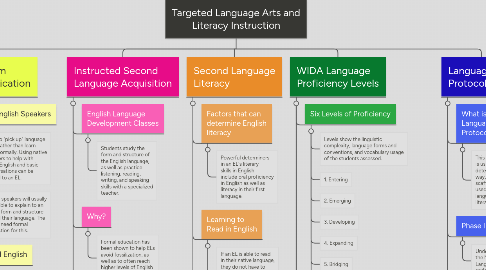
1. Classroom Communication
1.1. Native English Speakers
1.1.1. Tend to "pick up" language rules, rather than learn them formally. Using native speakers to help with social English and basic conversations can be helpful to an EL.
1.1.2. Native speakers will usually be unable to explain to an EL the form and structure behind their language. The EL will need formal instruction for this.
1.2. Standard English
1.2.1. The variety of the English language that is used and taught in a typical language arts classroom.
1.2.2. Often used in social and academic settings.
1.2.3. Can cause issues for ELs when they are still not orally proficient in in English.
1.3. Halliday
1.3.1. "Learning the Language"
1.3.2. "Learning About the Language"
2. Instructed Second Language Acquisition
2.1. English Language Development Classes
2.1.1. Students study the form and structure of the English language, as well as practice listening, reading, writing, and speaking skills with a specialized teacher.
2.2. Why?
2.2.1. Formal education has been shown to help ELs avoid fossilization, as well as to often reach higher levels of English proficiency.
2.3. When?
2.3.1. The earlier in an ELs development that formal English education begins, the better.
2.3.2. Has been shown to be especially helpful for adolescent students in Middle and High School settings.
3. WIDA Language Proficiency Levels
3.1. Six Levels of Proficiency
3.1.1. Levels show the linguistic complexity, language forms and conventions, and vocabulary usage of the students assessed.
3.1.2. 1. Entering
3.1.3. 2. Emerging
3.1.4. 3. Developing
3.1.5. 4. Expanding
3.1.6. 5. Bridging
3.1.7. 6. Reaching
3.2. Provides "Can Do" Descriptors
3.2.1. Helps by providing a good stating point for working with ELs in classes, and can also be a great collaborative planning tool.
3.3. Other ways to help determine proficiency
3.3.1. While this standardized assessment can help in seeing what level the EL is at, there are other ways to track their proficiency as it develops as well.
3.3.1.1. Collecting written and spoken language samples throughout the course of the year
3.3.1.2. Can give a more complete understanding of where students are in their proficiency levels.
4. Second Language Literacy
4.1. Factors that can determine English literacy
4.1.1. Powerful determiners in an EL's literary skills in English include oral proficiency in English as well as literacy in their first language.
4.2. Learning to Read in English
4.2.1. If an EL is able to read in their native language, they do not have to re-learn how to read in English. They just need to be able to understand the translation and syntax.
4.3. How language elements affect ELs reading
4.3.1. Vocabulary is often taugh to ELs, as well as native English speakers.
4.3.2. Sentence structure and word forms can be more complicated, and should be better explained by a teacher to an EL.
5. Language Arts Protocol
5.1. What is the Language Arts Protocol?
5.1.1. This is a tool that is used to help determine the way, and why, scaffolding can be used to help in language arts and literacy education.
5.2. Phase I
5.2.1. Understanding the Needed Language Skills and the Student
5.2.1.1. Step 1 in this phase includes identifying the language skills needed by the student to complete the lesson, Step 2 is to understand where the student is currently at their level of proficiency.
5.3. Phase II
5.3.1. Targeted Language Instruction
5.3.1.1. Step 1 is to figure out how to adjust the lesson. Step 2 involves figuring out how to use the scaffolding in the lesson (universally, supplemental, or alternatively). Step 3 is figuring out when to use the scaffolding and who should provide it.
